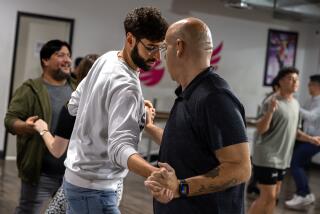Dancers improvise to survive in L.A.
Just past the front desk at the Equinox fitness club in Westwood, a sign encourages members to sign up for their free 15-minute Pilates session.
Next to the sign is Pilates instructor Ashley Hoffman, a 26-year-old with a porcelain complexion and full, reddish-brown hair. She and another trainer chat while waiting for spontaneous customers, but the fit-looking men and women checking in zoom by to the cardio and weight machines upstairs. There are no takers on this mid-December morning.
Hoffman has been at the club several hours already and has a long and eclectic day ahead of her. So she returns alone to the studio to warm up for her next stop — Reid Olson’s late-morning ballet class.
“It’s the class the professionals take, but the majority of the people taking it are not [professionals],” she says later, driving east on Olympic Boulevard toward Dance Arts Academy on South La Brea Avenue, where Olson, a onetime principal dancer, teaches a popular and crowded class.
Hoffman is a professional ballet dancer, and she has, against the odds, put together a busy freelance career. Los Angeles has for decades had a thriving if below-the-radar concert dance community of ballet, modern and ethnic dancers. These are women and men devoted to the art of dance, a mostly nonprofit world of dance-for-its-own-sake. It’s a community largely separate from that of commercial dancers, who find work in L.A. in music videos, at theme parks, in film and on television.
The concert dance community here is dynamic, thanks to the plethora of dance studios, strong university dance departments and an ongoing influx of professionals from around the country, including the nation’s dance capital, New York City. A performance career is highly competitive and short-lived, and dancers will seek out greener pastures for a chance to get onstage.
So what makes a dancer come to and stay in L.A.? And what are their lives like? The dancers interviewed for this story moved here for various reasons. But they have stayed, quite simply, because they have found artistically stimulating opportunities here.
Making art, and simultaneously making a living, is difficult anywhere, and its particularly challenging for dancers. Only 28 percent of dancers have full-year, full-time jobs, according to federal census data from 2005-2009 and analyzed by the National Endowment for the Arts.
Then there are the unique challenges of being a dancer in Los Angeles. The city’s defining characteristics are its broad expanses and the car that helps one navigate those distances. Creating a sense of community in this environment is difficult. You’re much less likely to bump into a friend by chance, as you might on the subway in New York City, said Meg Wolfe, a dance performance artist who arrived from Manhattan seven years ago.
She described the L.A. dance community as splintered into numerous “microclimates” — artists teaching at university and college dance departments; the many culturally specific dance companies, such as Mexican folkloric troupes; the commercial dance/film and video worlds. There is limited overlap, again, because of geography and the lack of a single dance center. The lack of a theater that presents only dance is another common complaint.
But there are upsides too in the Wild West nature of the dance scene. Artists are able to define themselves more easily here, Wolfe noted.
“Everyone’s got their own experience of what being a dancer in L.A. is … it feels like you can slip in and out of various scenes more readily here,” she said.
Hoffman’s experience seems to validate that assessment. Born and raised in a Chicago suburb, she moved here in spring 2007 to perform with Los Angeles Ballet, a then-new troupe established by Colleen Neary and Thordal Christensen. After a year and a half, Hoffman’s contract was not renewed and she was out of work. But she decided to stay to continue dancing professionally. She became accredited to teach Pilates and found she was in demand with a diverse group of smaller companies, among them Luminario Ballet, Sophie Monat Dance, and with independent choreographer Josie Walsh.
“You are part of such a small group, you wonder if anybody notices that you exist,” Hoffman said. “I think the movie and film industry does overpower the art and culture, and that can be frustrating at times. But, still, there is definitely an outlet for it [dance] here.”
The recent arrival of Benjamin Millepied’s L.A. Dance Project, which has backing from the Music Center, has created hope and excitement in the city’s dance universe. Hoffman went to the first audition in November and was one of the five finalists out of 57 who tried out. Millepied will be holding more auditions this month and next, but Hoffman said he told them he would be in touch.
“It seems like it would be really perfect, but you just don’t know what’s going to happen,” she said.
Hoffman steers her ’98 Dodge Stratus onto a side street to nab a parking space, scrutinizing the parking sign. She reaches into the back seat to grab an oversized bag stuffed with slippers, toe shoes, sweaters, tights and knitted leggings.
Technique class is critical for staying in shape, and Hoffman frequents professional-level classes at three studios. Class has other benefits as well. It provides social interaction and a sense of connection within a far-flung artistic community. Friends from class have passed along job tips too, Hoffman said. On this day, she will be meeting her occasional partner, Cuban-born Raydel Caceres. They have gotten permission to rehearse in the studio after class for a performance of “The Nutcracker” with Santa Clarita Ballet.
“I had envisioned myself trying to get into a large classical ballet company,” said Hoffman, speaking about her teenage dreams. “That was always the goal. But I also didn’t know about all the opportunities there are to do project work. I think I could never have envisioned my [current] path.”
Modern dance threw Chisa Yamaguchi onto an unexpected path. She was enrolled at UCLA and taking classes in Asian American studies, Japanese language and literature. She took a dance class her junior year — then another, just for fun.
“And the just-for-fun hobby became the phone call to my mom that I’m going to audition for the [dance] department,” said Yamaguchi, 27.
Her mother wanted to know what Plan B was. Yamaguchi didn’t have or want a Plan B. After graduation and six months of dance study in Senegal, she returned to Los Angeles to audition for companies.
“L.A. is not a city that really cherishes concert dance,” Yamaguchi said, recalling how she subsisted for a time on Cup O Noodles. “They were only looking for temporary dancers. ‘No, I want to do this for a living.’ After six months, I almost left. I’d cry after every single audition. I remember having $17 in my checking account. I was thinking, ‘How am I going to make this last?’”
But Yamaguchi hit pay dirt when she was invited into Diavolo Dance Theater, one of the city’s most prominent troupes. Now, in addition to performing with Diavolo, she wears a second hat as the company’s education director. Yamaguchi figures she could live on her Diavolo salary alone. But she has decided to keep her part-time “day” job, teaching gymnastics in Culver City. She figured she hadn’t had a full day off in a month.
Holding down several jobs is common. Michael Butler works as both performer and administrator for urban Latin dance company Contra-Tiempo, founded by Ana Maria Alvarez in 2005, after she got her master’s degree from UCLA. Raised in New York City and Charleston, S.C., Butler moved to Los Angeles with an eye on its range of dance opportunities. Butler was in the 2007 movie “Stomp the Yard,” and like some concert dancers, he is open to doing crossover work in film and television.
“I’m not a strong believer of the starving artist slogan,” said Butler, 27. “I wanted to find a way to sustain myself, not just going from gig to gig, to create some stability in my life and continue to do things that I love.”
Pay can vary wildly for freelance work, Hoffman noted. Rehearsal pay typically ranges from $25 to $50 an hour, while performance fees vary even more, between $200 and $1,000 per performance. A dancer might be paid for a performance only.
“You have to make a living,” she said. “I love dancing, but I’m doing it as a living.”
Back at Dance Arts Academy, Olson’s ballet class has ended and Hoffman and Caceres begin rehearsing the grand pas de deux for the Sugar Plum Fairy and her Cavalier. Behind them and off to the side, another couple are practicing a different “Nutcracker” duet. It’s an inconsiderate disruption, but neither Hoffman nor Caceres asks the other couple to leave. Still, Hoffman is distracted and the rehearsal does not go well. She cuts it short.
(This “Nutcracker” turned into a lesson in the vagaries of the artistic life. A last-minute cast change was made and Hoffman did not perform after all, although she was paid. “Sometimes gigs don’t work out the way you planned,” she said. “You have to continue to move forward and grow from the experience, no matter what happens.”)
Returning to her car, Hoffman perks up when she sees she does not have a parking ticket. Heading back to Equinox, she grabs a salad in the club’s café. She has a 4 p.m. appointment at the Bel-Air home of a Pilates client. The woman hired Hoffman to give private dance lessons to her two daughters and a third girl. While she eats, Hoffman downloads songs to use during the class. After the lesson, she will be done, one of her early days. At least three times a week, Hoffman has Pilates clients until 8 p.m.
Hoffman acknowledged that her life is not terribly secure. But she said in the mix of work, she has found artistic satisfaction. And her love for dancing is as strong as ever.
“I would say I’m happier now than I probably have ever been in my life. It doesn’t mean that everything is absolutely perfect. But I think I spent so many years being unsure of what I want. I’m doing what I always wanted — dancing professionally in contemporary [ballet]. With my personality, I wouldn’t have been able to do it any other way.”
More to Read
The biggest entertainment stories
Get our big stories about Hollywood, film, television, music, arts, culture and more right in your inbox as soon as they publish.
You may occasionally receive promotional content from the Los Angeles Times.






